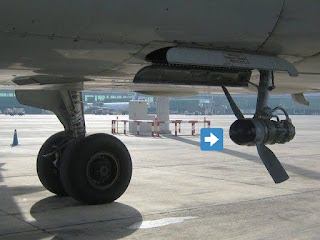What Is Ram Air Turbine (RAT) And It's Function In Aircraft Mechanism.
The recent aircrash of Pakistan International Airlines Airbus A320 operated as PK8303 near Karachi International Airport brought to limelight Ram Air Turbine in aircraft operations. Based on pictures taken of the doomed aircraft just minutes before it crashed, showed clearly the deployment of the RAT.
What exactly is RAT?
A Ram Air Turbine (RAT) is a turbine that is installed in an aircraft and used as an alternate or emergency hydraulic or electrical power source. The RAT generates power from the airstream based on the speed of the aircraft and is connected to an electrical generator or to a hydraulic pump.
Modern aircraft only utilize the RAT in emergency: either in the event of loss of hydraulic systems or following the loss of primary electrical generation. In these cases the RAT will power vital systems such as flight controls or flight-critical instrumentation, navigation and communication equipment. Some RATs produce only hydraulic power which in turn is used to power an electrical generator.
Under normal conditions, the RAT is stowed in a compartment in the fuselage or wing. It can be deployed manually when required or, in some installations, will deploy automatically following a complete loss of AC power. In the interval between power loss and RAT deployment, aircraft batteries are used to power essential instrumentation.
Why was it deployed?
Based on initial reports and ATC recordings, the pilot had earlier performed a 'go around' due to issues with the landing gear. He then reported 'lost engines' and subsequently declared a 'Mayday' which going by the definition of the use of RAT above, points to the fact why the Ram Air Turbine was deployed.
If the main function of the Ram Air Turbine is to provide an alternate or emergency hydraulic or electrical power source in times of emergency, why then did the aircraft crash?
This will squarely be a focal point among other issues for investigators both from the Pakistan Civil Aviation Authority and the aircraft manufacturer Airbus to analyze.
Simon Ogboji
Picture credit: pinterest





Comments
Post a Comment